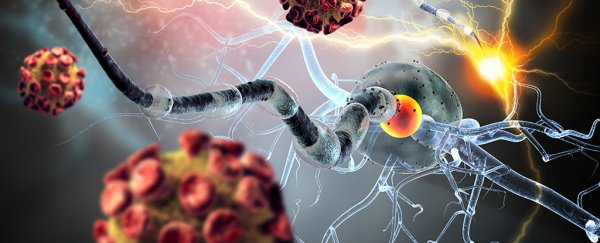News on the emergence of the mosquito-borne Zika virus in recent years has been full of heart-breaking images of infants born with a confronting neurological disorder caused by the pathogen's effects on certain stem cells.
Now researchers are proposing a daring use for the virus's talent for destroying these kinds of brain tissues; to turn it loose on an aggressive form of cancer called a glioblastoma.
The study, conducted by scientists from Washington University School of Medicine and the University of California, San Diego, has demonstrated Zika virus can preferentially infect and kill glioblastoma stem cells cultured outside the body.
In addition, mice which had an adapted strain of the virus injected into their tumours lived longer as a result.
Both sets of results provide some hope of a novel form of treatment for a highly malignant type of cancer that is difficult to destroy.
Glioblastomas form as the brain's so-called 'glue cells', or glia, grow out of control. The tumours that result are usually removed surgically, with chemotherapy and radiotherapy prescribed to mop up any leftover cancerous cells.
Unfortunately their branching structures and the diverse types of cells that make up the tumours make these cancers difficult to treat.
Less than a third of patients with more aggressive forms of the disease live to see another two years, making it a rather bleak outlook for those receiving the diagnosis.
This new approach to treating glioblastoma makes use of the properties of a microbe that has a reputation for causing a very different kind of disease.
Surprisingly, this isn't the first instance of a pathogen being commissioned to fight this kind of brain tumour.
Earlier this year researchers reported their success in treating glioblastomas in rats with engineered strains of the bacterium Salmonella.
Zika virus has been on epidemiologist's radar since the mid-20th century, but first rose to global notoriety in 2015 following an outbreak in Brazil, where it was blamed for a significant rise in newborns with a condition called microcephaly.
The most striking feature of this disorder is the lack of brain growth that gives rise to a smaller skull, developmental delays, feeding difficulties, and hearing loss.
In adults the virus is usually produces symptoms that are far less severe, limited to fever, rash, headache, joint pain, and in some rare cases, inflammation of the nervous system's covering, or meninges.
Recent research on the Asian lineage of the virus responsible for the 2015 outbreak found it stopped the growth of stem cell tissues in the brain and prevented them from turning into nerve cells.
This preference for interfering with the development of certain lines of stem cells is disastrous for developing embryos, but it could also be the perfect silver bullet to polish off glioblastomas.
"We showed that Zika virus can kill the kind of glioblastoma cells that tend to be resistant to current treatments and lead to death," says researcher Michael S. Diamond from Washington University School of Medicine.
Chemotherapy and surgery can remove the bulk of the cancerous tissue, but tends to leave stray stem cells that continue to proliferate and give rise to a new mass near the previous tumour site.
Adding the virus to the mix could be the perfect one-two-three punch for cleaning up the scraps.
"We see Zika one day being used in combination with current therapies to eradicate the whole tumour," says researcher Milan G. Chheda, also from Washington University School of Medicine.
The team tested the virus on 18 mice with the equivalent of glioblastomas, comparing them against 15 that were injected with a saltwater control. Two weeks after treatment, the tumours were significantly smaller in the Zika-infected mice.
You can be forgiven for any apprehensions over injecting a virus known for causing brain damage directly into patients' brains.
But while there is plenty of research to be done before the virus could even be considered a viable option for cancer treatment, the fact it only targets cells that are rare in adult nervous systems makes them a relatively safe bet.
The researchers also induced mutations that weakened the virus's ability to defend itself against the immune system. While it also made it less potent, the virus still managed to kill stem cells.
"We're going to introduce additional mutations to sensitise the virus even more to the innate immune response and prevent the infection from spreading," says Diamond.
It's certainly a somewhat unconventional approach to treating brain cancer. But then again, glioblastoma isn't your average cancer.
This research was published in the Journal of Experimental Medicine.
